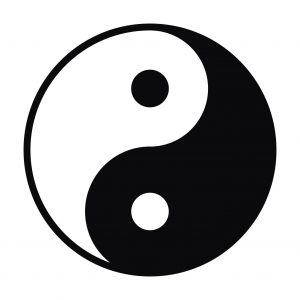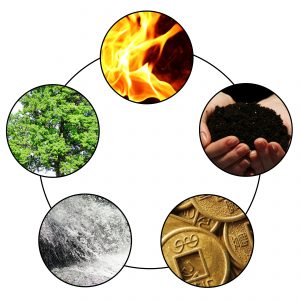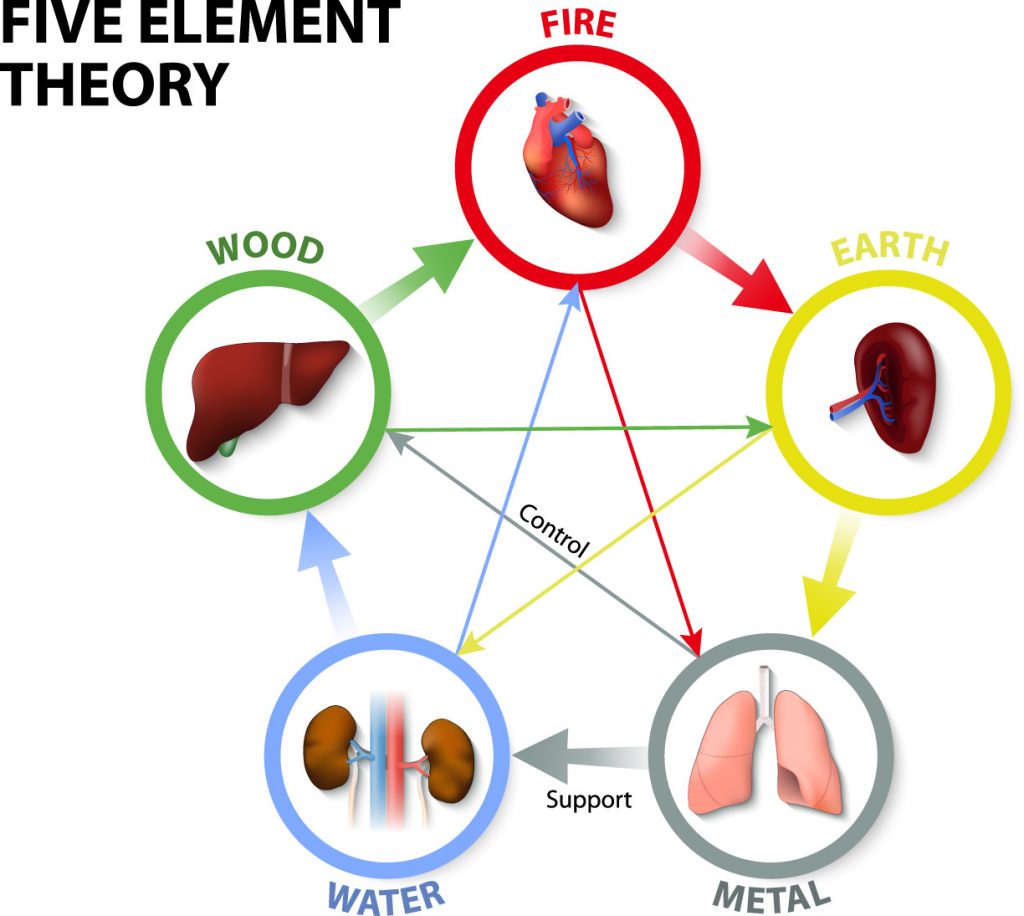The Five Elements are a model of how energy moves in nature and within our bodies. The Twelve Officials are descriptive job titles given to the organs and functions in our body. They are seen as Ministers overseeing functions in the body and each Minister is linked to a Meridian or energy pathway. Together they provide a way of describing and assessing how the energy moves through our bodies. The flow of this energy can be felt on the pulses and is what acupuncturists work with when doing a diagnostic assessment and treatment. The interrelationships between the Elements and the Meridians enable the flow of that energy to be assessed and any imbalances to be identified. These imbalances can give an insight into the underlying activities in the body.
At the heart of the philosophy from which traditional acupuncture derives lies the study of life, the Tao. The word itself means a road or path but the Tao represents a way of living in tune with the ever-changing cycles of nature to sustain us. The Tao has two polar aspects which represent the duality of nature as in night and day. These are known as Yin/Yang which

‘Nature is in constant motion, following cyclic patterns that describe the process of transformation. When the elements of nature are in balance, life is harmonic and flourishes. When the balance of polar forces is upset, disaster looms.’
Beinfield and Korngold 1991 Between Heaven and Earth
The elements, forces and cycles of nature are all around us. And because each individual is a microcosm of the universe they are also within us. In Chinese philosophy, all life is made up of the Five Elements which are Wood, Fire, Earth, Metal and Water. We are often aware of these Elements around us. We see Wood in the trees and Fire in the sun, we feel the Earth beneath our feet, we use Metal in some way every day and we drink Water to quench our thirst. Each Element is basic to life and the Elements work together to produce and to sustain life without any Element working in isolation.

‘Health is the harmonious balanced cyclic interaction of these Elements. Health is maintained only when the Energy flowing through each of the Elements is clear and
Beinfield and Korngold 1991 Between Heaven and Earthlifegiving .’
There are recognised correspondences between each of the Elements and the seasons of the year, colours, sound, odour, emotion and many more
| Element | Season | Colour | Sound | Odour | Emotion |
| Wood | Spring | Green | Shouting | Rancid | Anger |
| Fire | Summer | Red | Laughing | Scorched | Joy |
| Earth | Late Summer | Yellow | Singing | Fragrant | Sympathy |
| Metal | Autumn | White | Weeping | Rotten | Grief |
| Water | Winter | Blue | Groaning | Putrid | Fear |
The Twelve Officials
The Twelve Officials are the Ministers overseeing the Twelve Meridians and are closely interrelated with the Five Elements. Each Official/Meridian is associated with a major organ and function of the body and with one of the Elements. When viewed as a group the Twelve Officials can be likened to a government of ministers and officials, each with its own title, who work together to run the body as a whole. When each Official is doing its job properly the body is working well but if any Official falls behind or is failing the body is out of balance. I like to think of this as an orchestra. When the orchestra play well together they produce beautiful music. When they are playing different tunes at the same time the effect is less than harmonius!
The Officials are paired in line with their associations with the Elements and within each pair of Officials one of the organs is predominantly Yin and is a solid, blood filled organ while the other is predominantly Yang and is a hollow organ. The Yin organs or the zang are known as the treasure organs. The Yang organs or the fu are known as the workshop organs. The Yang organs are there to assist in processing what the Yin organs direct them to do. As each pair of Officials is associated with one of the Elements, with the Fire Element being responsible for two pairs of Officials, it is convenient to consider the Officials with these associations in mind.
For the Metal Element the Yin Official is the Lungs which are known as the ‘Receiver of Qi from the Heavens’ and the Yang Official is the Large Intestine, known as the Official responsible for the ‘Drainage of the Dregs’. The Lungs take in heavenly Qi and the Large Intestine lets go by eliminating refuse which together epitomise Metal’s season of autumn when goodness is taken into store for the winter and when there is generally a time for letting go.
For Water the Yin Official is the Kidneys, the ‘Controller of Fluids’, and the Yang Official is the Bladder, the ‘Controller of the Reservoir’. The Kidneys are responsible for the creation of power and the Bladder works with the power of the Kidneys and distributes and stores fluids around the body, again reflecting Water’s season of winter, a time of preserving resources and of conserving energy.
For Wood the Yin Official is the Liver, the ‘Official in Charge of Strategic Planning’ or ‘The General’, and the Yang Official is the Gall Bladder, the ‘Official in Charge of Judgements and Decisions’. The Liver is responsible for planning, for looking forward and having vision in all respects while the Gall Bladder brings into effect the schemes of the Liver by providing the details as to how they are to be achieved, activities essential to Wood’s season of spring with its springing to life and the start of new growth.
For
For Earth the Yin Official is the Spleen, the ‘Transformer and Transporter Official’, and the Yang Official is the Stomach, the ‘Rotter and Ripener’ of food and drink. The Spleen and the Stomach work closely together with the Stomach receiving food, processing it and then passing on food energy to be distributed by the Spleen which is considered to be the source of life for the other organs and between them they fulfil the harvesting and nourishment aspects of Earth’s season of late summer.
Qi flows through the body in a number of channels known as meridians. There are twelve primary meridians each of which is identified with one of the Twelve Officials. These meridians can be ‘read’ by taking a person’s pulses, six of which are taken on the radial artery of each wrist. The Twelve Officials speak to us – and want to speak to us – through these pulses.
The Elements make themselves known to a practitioner by a variety of signs but most readily by colour, sound, odour and emotion in accordance with the correspondences outlined above. Each person has a predominant Element which is known as that person’s Causative Factor or CF. It accounts for both strengths and weaknesses in a person and, in the Five Element model, it lies at the root of energetic imbalances and symptoms.
There are two cycles by which the Elements and the Officials relate to each other, the Sheng cycle and the K’e cycle, which between them keep a dynamic balance between the Elements and the Officials.
Generative and Controlling Cycles
The Generative or Sheng cycle, which is also known as the Law of Mother/Child, is a cycle whereby each Element or Official is generated and nourished by the Element or Official which precedes it in the cycle and in turn generates and nourishes the Element or Official which follows it. In terms of the Elements the sequence is Wood, Fire, Earth, Metal, Water and then back to Wood.

‘On and on the cycle passes from Element to Element in a process of continual creation. Each Element is produced by and produces another. No one of them is more important than another.’
Connelly 1994 Traditional Acupuncture
Examples of this cycle can be seen in nature: fire is produced by burning wood; the earth contains minerals which make up metals.
It can be said that Metal is the mother of Water while at the same time it is the child of Earth. Under the Law of Mother/Child an Element or Official may be in trouble or out of balance if it is not being nourished by its mother Element or Official or if its child Element or Official is taking too much nourishment from it.
The Controlling Cycle or K’e cycle ensures that a balance is maintained between the Elements and the Officials. In terms of the Elements the cycle is that Wood controls Earth, Earth controls Water, Water controls Fire, Fire controls Metal and finally Metal controls Wood.
Again, examples of this cycle can be seen in nature: water can be used to extinguish fire; metal can be used to fell wood in the form of trees. Along the K’e cycle an Element or Official may be out of balance if it is controlled too much by or if it rebels against its controller.
The Sheng and K’e cycles are interrelated. For example Metal controls Wood but Wood generates Fire which controls Metal. Or again Metal controls Wood but it also generates Water which in turn generates Wood. This interrelationship should always result in a self-regulating balance being maintained.
Law of Midday/Midnight or 24 Hour Cycle

Each Official has a two hour period of maximum efficiency during each 24 hour day. There is a corresponding two hour period of minimum activity 12 hours later when the Official is at its lowest ebb. The two hour period of maximum efficiency for the Heart starts at 11.00a.m. and is followed in sequence by the Small Intestine, the Bladder, the Kidneys, the Pericardium, the Triple Heater, the Gall Bladder, the Liver, the Lungs, the Large Intestine, the Stomach and the Spleen. Working round this sequence we can see that the Heart is at its most efficient at midday and at its least efficient at midnight, the most frequent times for Heart attacks.
The Lungs are at their best for two hours from 3.00a.m. when heavenly Qi is at its most potent. The Large Intestine is at its most active from 5.00a.m. to 7.00a.m. thereby emptying the body in readiness for receiving during the active periods for the Stomach and the Spleen from 7.00a.m.to 11.00a.m. Symptoms which appear and disappear regularly during the day are likely to correspond directly to the ebb and flow of Qi which passes through the primary meridians in the same sequence as the Twelve Officials follow around the 24 hour clock. For example a person with a Heart problem could feel better or worse between 11.00a.m. and 1.00p.m. depending whether his imbalance is a deficiency or an excess although it must be borne in mind that a symptom could be linked to the Official which is at rest at the time.
It can be seen that the Five Elements and Twelve Officials model can give information and insight into the body which are not used in Western medicine and as such represent for us a new way of looking at the body. The diagnosis of the Causative Factor will indicate the pair of Officials most likely to be out of balance. The pulses can tell us how all the Officials are getting on and the application of the Sheng and the K’e cycles may help to identify the cause of any imbalance revealed. Symptoms occurring at regular times each day could indicate an imbalance in the Official which is at its most or least active during the time in question. All of these factors will assist a traditional acupuncturist to balance the Qi within a body in order to maintain health and to reduce the likelihood of disease.
